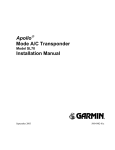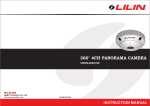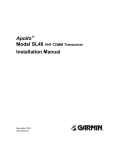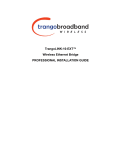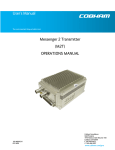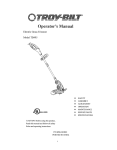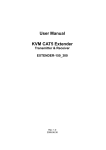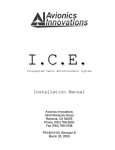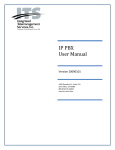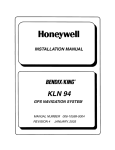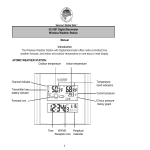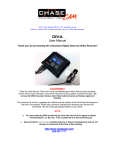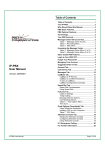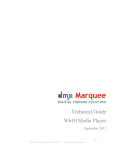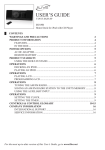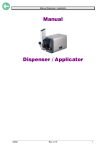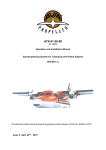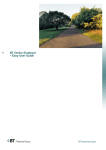Download Apollo SL70 Installation Manual
Transcript
Apollo Mode A/C Transponder Model SL70 Installation Manual October 1999 560-0402-00a 1999 by UPS Aviation Technologies. All rights reserved. Printed in the U.S.A. No part of this document may be transmitted, reproduced, or copied in any form or by any means without the prior written consent of UPS Aviation Technologies. Due to our commitment to constantly improve the quality and performance of our products, information contained in this document is subject to change without notice. UPS Aviation Technologies and Apollo are registered trademarks of UPS Aviation Technologies. UPS Aviation Technologies P.O. Box 13549 Salem, OR 97309 Phone (503)581-8101 1-800-525-6726 In Canada 1-800-654-3415 FAX (503)364-2138 2345 Turner Rd. S.E. Salem, OR 97302 U.S.A. HISTORY OF REVISIONS Revision --00a Date 8/26/99 10/4/99 Description Initial release. Added new connector pins and crimping tools, added radar altimeter checkout and limitations IMPORTANT NOTE The conditions and tests required for TSO approval of this article are minimum performance standards. It is the responsibility of those desiring to install this article on or within a specific type or class of aircraft to determine that the aircraft operating conditions are within TSO standards. The article may be installed only if further evaluation by the applicant documents an acceptable installation and is approved by the Administrator. ORDERING INFORMATION To receive additional copies of this publication, order part # 560-0402, Apollo SL70 Mode A/C Transponder Installation Manual. REFERENCE PUBLICATIONS Following are other publications referenced in this guide. NOTES Table of Contents TABLE OF CONTENTS SECTION 1 - INTRODUCTION................................................................................................. 1 ABOUT THIS MANUAL ...................................................................................................................... 1 APOLLO SL70 DESCRIPTION ............................................................................................................. 1 FEATURES ......................................................................................................................................... 2 REGULATORY COMPLIANCE ............................................................................................................. 2 UNPACKING THE EQUIPMENT............................................................................................................ 3 PACKAGE CONTENTS ........................................................................................................................ 3 OTHER REQUIRED MATERIALS ......................................................................................................... 3 SPECIAL TOOLS REQUIRED ............................................................................................................... 4 SECTION 2 - INSTALLATION .................................................................................................. 5 PRE-INSTALLATION INFORMATION.................................................................................................... 5 INSTALLATION OVERVIEW ................................................................................................................ 5 INSTALLATION CONSIDERATIONS...................................................................................................... 5 MOUNTING CONSIDERATIONS.................................................................................................................................... 5 MINIMUM SYSTEM CONFIGURATION ......................................................................................................................... 5 ALTITUDE INPUT........................................................................................................................................................ 5 ANTENNA .................................................................................................................................................................. 6 EQUIPMENT MOUNTING .................................................................................................................... 6 UNIT INSTALLATION / REMOVAL ............................................................................................................................... 7 ELECTRICAL CONNECTIONS .............................................................................................................. 7 POWER ...................................................................................................................................................................... 8 ALTITUDE INPUT........................................................................................................................................................ 8 SERIAL INTERFACE .................................................................................................................................................... 8 DISCRETE INPUTS ...................................................................................................................................................... 8 ANTENNA INSTALLATION AND CONNECTIONS .................................................................................. 9 POST INSTALLATION CHECKOUT..................................................................................................... 12 TEST MODE CHECKOUT AND SETUP ........................................................................................................................ 12 OPERATION / PERFORMANCE CHECKOUT ................................................................................................................ 13 INSTRUCTIONS FOR CONTINUED AIRWORTHINESS........................................................................... 15 SECTION 3 - SPECIFICATIONS............................................................................................. 17 ELECTRICAL ................................................................................................................................... 17 PHYSICAL ....................................................................................................................................... 17 ENVIRONMENTAL ........................................................................................................................... 18 ALTITUDE INPUT ............................................................................................................................. 18 DISCRETE INPUTS ........................................................................................................................... 18 SERIAL INTERFACE ......................................................................................................................... 18 TRANSPONDER PERFORMANCE ....................................................................................................... 19 ANTENNA REQUIREMENTS.............................................................................................................. 19 SECTION 4 - LIMITATIONS ................................................................................................... 21 INSTALLATION ................................................................................................................................ 21 OPERATIONAL ................................................................................................................................ 21 APPENDIX A - TROUBLESHOOTING.................................................................................. 23 CONTACTING THE FACTORY FOR ASSISTANCE ................................................................................ 24 Apollo SL70 Installation Manual i Table of Contents APPENDIX B - PERIODIC MAINTENANCE ....................................................................... 25 BIENNIAL CHECK ........................................................................................................................... 25 CLEANING THE FRONT PANEL ........................................................................................................ 25 APPENDIX C - ENVIRONMENTAL QUALIFICATIONS .................................................. 27 APPENDIX E - SERIAL DATA PROTOCOL ........................................................................ 29 ALTITUDE INPUT / OUTPUT ......................................................................................................................................29 LIST OF TABLES TABLE 1 TABLE 2 TABLE 3 TABLE 4 PACKAGE CONTENTS ........................................................................................................ 3 REAR CONNECTOR PINOUT ............................................................................................. 20 TROUBLESHOOTING GUIDE ............................................................................................. 23 ALTITUDE DATA FORMAT ............................................................................................... 29 LIST OF FIGURES FIGURE 1 FIGURE 2 FIGURE 3 FIGURE 4 FIGURE 5 FIGURE 6 FIGURE 7 ii SL70 FRONT PANEL ........................................................................................................ 2 MOUNTING FRAME ASSEMBLY ........................................................................................ 6 CABLE ROUTING .............................................................................................................. 7 COAX CABLE ASSEMBLY................................................................................................. 9 WIRING DIAGRAM - GRAY CODE ALTITUDE INPUT ....................................................... 10 WIRING DIAGRAM - SERIAL ALTITUDE INPUT................................................................ 11 UNIT DIMENSIONS ......................................................................................................... 17 Apollo SL70 Installation Manual Introduction SECTION 1 - INTRODUCTION ABOUT THIS MANUAL This manual describes the installation of the Apollo SL70 transponder . It is intended for use by persons certified by the Federal Aviation Administration (FAA) to install aircraft avionics. Section 1 Provides an introduction to the Apollo SL70 unit. TSO certification information is also included in this section. Section 2 Includes installation and checkout procedures. Section 3 Includes complete specifications. Section 4 Includes limitations for the equipment and installation. Appendix A Includes troubleshooting information. Appendix B Includes periodic maintenance requirements. Appendix C Includes the environmental qualification form. Appendix E Includes serial data protocol specifications. APOLLO SL70 DESCRIPTION The Apollo SL70 is a TSO-C74c, Class A2, mode A/C transponder. The SL70, in addition to providing replies to ATC interrogations, includes an altitude display and altitude hold function and user-friendly interface features including rotary knob squawk code selection, a VFR button, and built-in self-test and diagnostics. Apollo SL70 Installation Manual 1 Introduction Figure 1 SL70 Front Panel FEATURES • small size 1.3” panel height • full range input supply voltage • high brightness LED display • altitude display • altitude hold function • gray code or RS-232 serial data altitude input • RS-232 altitude data output • built-in self-test and diagnostics REGULATORY COMPLIANCE The Apollo SL70 is designed and tested to meet the following TSO: • FAA TSO-C74c, Class A2 The SL70 complies with the FCC requirements specified in: • CFR 47, Part 87, Aviation Services, Subpart D, Technical Requirements The SL70 software is designed and tested to RTCA/DO-178B, level C. Note: Un-authorized changes or modifications to the SL70 may void the compliance to regulatory agency requirements and authorization for continued equipment usage. 2 Apollo SL70 Installation Manual Introduction UNPACKING THE EQUIPMENT Carefully unpack the equipment. Visually inspect the package contents for any evidence of shipping damage. Retain all shipping containers and packaging material in case reshipment is necessary. PACKAGE CONTENTS As shipped from the UPS Aviation Technologies factory, the Apollo SL70 package includes most necessary items for installation other than supplies normally available at the installation shop, such as wire and coax cable, the antenna, or any optional switches. The items included in the package are listed in Table 1. Table 1 Package Contents Part # Description Apollo SL70 Installation Kit, Part # 424-0306-xx 162-0103 or 37 pin dsub connector shell 162-1577 162-0043 Right angle coax plug 202-0001 Cable tie 204-0037 Edge grommet 221-0400 4-40 x ¼ SS pan head Phillips machine screw with lock washer 224-0404 4-40 x ¼ flat head Phillips machine screw 240-0008 9/16 OD flat washer 245-0022 or Crimp contact for dsub, 20 to 24 awg wire 245-0027 265-0007 7/16” retaining ring 310-2295-00 Connector mounting bracket 310-5181-00 Mounting frame 998-0048 3/32 hex driver Apollo SL70 Manual Kit, Part # 564-0072-xx 560-0401-00 SL70 User’s Manual 560-0402-00 SL70 Installation Manual Qty 1 1 2 6” 10 2 1 37 1 1 1 1 1 1 OTHER REQUIRED MATERIALS In addition to the materials supplied with the SL70, the following is required. • a suitable 2A circuit breaker • an altitude data source – either gray code or RS232 • a standard transponder antenna (see Antenna information on pages 6 and 19) Apollo SL70 Installation Manual 3 Introduction SPECIAL TOOLS REQUIRED Crimp Tool A crimp tool meeting MIL specification M22520/1-01 and a positioner/locater are required to ensure consistent, reliable crimp contact connections for the rear 15 pin connector. These tools are available from: For pin p/n 162-0100 Astro Tool Corp. 21615 SW TV Highway Beaverton, OR 97006 Phone (503) 642-9853 Fax (503) 591-7766 Crimp tool: Positioner: Astro Tool part #615708 Astro Tool part #616356 For pin p/n 162-1575 4 ITT Cannon 1851 E. Deere Ave. Santa Ana, CA 92705-6500 Phone (714) 261-5300 Fax (714) 575-8324 Insertion tool: Regular duty Crimp tool: Regular duty Locator tool: Heavy duty Crimp tool: Heavy duty Locator tool: ITT part # 274-7006-000 (Desc. CIET-20HD) ITT part #995-0001-585 (Desc. M22520/1-01) ITT part #995-0001-244 (Desc. TH25) ITT part #995-0001-584 (Desc. M22520/2-01) ITT part #995-0001-604 (Desc. M22520/2-08) Apollo SL70 Installation Manual Installation SECTION 2 - INSTALLATION This section describes the installation of the Apollo SL70 including mounting, wiring, and connections. A post installation check-out procedure is included at the end of this section. PRE-INSTALLATION INFORMATION Always follow good avionics installation practices per FAA Advisory Circulars AC 43.13-1B, 43.13-2A, or current FAA guidance. Follow the installation procedure in this section as it is presented for a successful installation. Read the entire section before beginning the procedure. Perform the post installation checkout before closing the work area in case problems occur. INSTALLATION OVERVIEW A successful installation should start with careful planning including determination of mounting location for the SL70, antenna location and mounting, connections to an altitude data source, power, cable routing, and other required modifications. Once the mounting location has been determined, prepare the mounting frame for installation. It may be easier to complete the wiring harness and attach the connectors to the mounting frame prior to installing the mounting frame in the aircraft. INSTALLATION CONSIDERATIONS MOUNTING CONSIDERATIONS The SL70 is designed to mount in the avionics stack in the aircraft instrument panel within easy view and reach of the pilot. The standard package includes the mounting frame for ease of mounting, connections, and service of the unit. Allow an additional one inch clearance to the rear of the mounting frame for connections and cables. For typical installations, the SL70 does not require external cooling. When mounting the unit, leave a clearance of 1/8 to 1/4 inch between avionics to allow for air circulation. MINIMUM SYSTEM CONFIGURATION The SL70 requires connections to the following equipment as a minimum: • power input • altitude data – gray code or RS232 • a standard transponder antenna ALTITUDE INPUT The SL70 can use either a standard altitude gray code input from an encoding altimeter or an RS-232 input from a serial encoder. For new installations, a serial encoder is recommended because it simplifies the wiring and is more reliable. The SL70 can detect failures on the RS232 input, thereby eliminating erroneous mode C altitude replies. Apollo SL70 Installation Manual 5 Installation The altitude source must be accurate to within ±125 feet, 95% probability, and have a resolution of 100 feet (the serial input resolution may be better than 100feet). ANTENNA The antenna shall be a standard transponder quarter wave monopole antenna, such as the TED #104-12 or Comant CI-101. EQUIPMENT MOUNTING Once the cable assemblies have been made, attach the 37 pin dsub and coaxial cable connectors to the rear connector mounting plate and the mounting frame as illustrated in Figure 2 and Figure 3. Route the wiring bundle as appropriate. The rear connector plate should be attached to the mounting frame before installing the frame in the instrument panel. The rear connector plate can be used to tie down the cable assemblies. Connect the shields on any shielded cables directly to the connector mounting plate. Figure 2 Mounting Frame Assembly 6 Apollo SL70 Installation Manual Installation Figure 3 Cable Routing Once the cable assemblies are complete and the connectors are attached to the mounting frame, install the mounting frame assembly in the aircraft instrument panel. Be sure to use low profile head screws so the unit will slide in and out freely. Attach the front of the mounting frame to the instrument panel. Use support brackets to attach the rear of the frame to the aircraft. UNIT INSTALLATION / REMOVAL To install the SL70 in the mounting frame, make sure the cam lock is rotated so the rear part is up, then slide the unit into the frame and tighten with the 3/32 hex tool. The unit will be pulled into the frame by the cam lock and the connectors will fully engage. To remove the SL70 from the mounting frame, use the hex tool and turn the tool CCW. The unit will be pushed out of the frame by the cam lock assembly. No special extraction tools are required. ELECTRICAL CONNECTIONS The SL70 installation kit includes a 37 pin dsub shell and crimp contacts. The crimp contacts are specified for 20 to 24 AWG wire. Make the crimp connections with a crimp tool as specified in the Special Tools Required section on page 4. All wires should be 20 to 24 AWG unless otherwise specified. Wiring diagrams are included on pages 10 and 11. Apollo SL70 Installation Manual 7 Installation POWER The SL70 is internally fused at 3 amps. A separate 2 amp circuit breaker or fuse should be installed for downline overload or short circuit protection. Make the power connections to the SL70 using 20 AWG wire. Note: Circuits should be protected in accordance with guidelines in AC 43.13-1B, chapter 11, section 4. ALTITUDE INPUT The SL70 can use altitude data from either a standard gray code altitude or from an RS-232 serial altitude source. If using the gray code altitude input, connections can be made directly from the SL70 to the altitude source. Isolation diodes are included within the SL70. Make sure a common ground connection exists, or connect a ground wire between the source and the SL70. If using the RS-232 serial altitude input, make the connections as described in the following section. SERIAL INTERFACE The SL70 includes an RS-232 serial port which can be used for inputting or outputting altitude data. This is an optional connection if the altitude gray code input is used. When making serial connections to the SL70, use a shielded two or three conductor cable. Make the RxD, TxD, and serial ground connections on the 37 pin dsub connector. Connect the shield to the rear of the mounting frame on the connector plate. Complete serial interface specifications are included in Appendix E. DISCRETE INPUTS Remote Ident The ident input can be connected to a remotely mounted momentary switch to initiate the ident function the same as using the front panel IDENT button. When using the ident input, connect it to a remotely mounted momentary switch, and connect the other terminal of the switch to ground. Remote Standby The standby input is for use when the installation includes more than one transponder. When two transponders are installed, connect the standby input to a two position selector switch, with the common on the switch connected to ground. The SL70 will be in standby when the input is pulled low to ground. Suppresion Input The suppress input is used when installed with a DME that includes a suppression output. The transponder will be suppressed, or will not generate replies, when the input is driven high from the DME (or other source). To use the suppression input, connect it to the suppression output on a DME (or other appropriate suppression source). 8 Apollo SL70 Installation Manual Installation ANTENNA INSTALLATION AND CONNECTIONS The antenna should be mounted in a vertical position in an area on the bottom of the aircraft away from other antennas or landing gear. The antenna coax cable should be a double shielded low loss cable and must have a cable loss of < 3 dB at 1090MHz, including connectors. A typical installation should have a cable loss of 1½ to 2 dB. Several suitable coaxes are RG142B and RG400. The assembly of the rear panel coax connector included with the installation kit is illustrated in the following figure. Shield 0.250 Cable 1.000 0.125 STEP 1 Insulation -Slide shrink tube over cable. -Strip cable as shown. Shrink Tube .125 STEP 2 -Flare Outer Shield as Shown Cap Solder Outer Shield to Connector STEP 3 Matching Ring Solder Center Conductor -Place cable in connector as shown placing inner shield inside connector. -Flatten outer shield against connector. -Solder outer shield to connector. -Solder center conductor -Slide matching ring into connector and around conductor. -Attach cap. Solder Cap 2 Places STEP 4 -Solder cap into place, 2 Places. -Shrink tube as shown. Figure 4 Coax Cable Assembly Apollo SL70 Installation Manual 9 Installation SL70 Transponder 2A Breaker Power 1 + Ground 2 - C4 15 C2 34 Avionics Power Altitude Encoder or C2 Digitizer C4 C1 C1 16 B4 32 B4 B2 14 B2 B1 33 B1 A4 12 A4 A2 31 A2 A1 13 A1 D4 35 D4 Ground 30 Ground Ident 10 Standby 29 Note 2 (Optional) Suppress 19 Note 3 (Optional) Ground 37 Suppress return TxD 5 RxD 4 Ground 3 Remote Ident (Optional) GPS Unit RS-232 Serial Altitude Output (Optional) RxD Ground Shielded Cable Chassis Ground Chassis Ground Coax Cable To Antenna Notes: 1. Select the gray code input in the setup mode when using the parallel gray code altitude input. 2. Use standby input to select between two transponders using a selector switch. Unit is in standby when input switched to ground. 3. Suppression input, typically connected to DME suppression output. Transponder is suppressed when input is high. Figure 5 Wiring Diagram - Gray Code Altitude Input 10 Apollo SL70 Installation Manual Installation SL70 Transponder 2A Breaker Power 1 + Ground 2 - C4 15 C2 34 C1 16 B4 32 B2 14 B1 33 A4 12 A2 31 A1 13 D4 35 Ground 30 Ident 10 Standby 29 19 Note 3 (Optional) Ground 37 Suppress return TxD 5 RxD 4 Ground 3 Remote Ident (Optional) Note 2 (Optional) Suppress Avionics Power Altitude Encoder or Serializer RS-232 Serial Altitude Input TxD Ground Shielded Cable Chassis Ground Chassis Ground Coax Cable To Antenna Notes: 1. Select altitude input in the setup mode when using RS-232 serial altitude input. 2. Use standby input to select between two transponders using a selector switch. Unit is in standby when input switched to ground. 3. Suppression input, typically connected to DME suppression output. Transponder is suppressed when input is high. Figure 6 Wiring Diagram - Serial Altitude Input Apollo SL70 Installation Manual 11 Installation POST INSTALLATION CHECKOUT Once the unit is installed, complete the checkout procedure to verify proper operation. Refer to the user’s guide for operating instructions. The steps that are not applicable to a particular installation may be skipped. Fill out the checkout log sheet during the checkout procedure. The log sheet of page 14 may be photocopied if desired. Mounting / Wiring Check Verify that all cables are properly secured and shields are connected to the rear of the mounting frame. Check that cables do not interfere with the movement of the aircraft controls. TEST MODE CHECKOUT AND SETUP The SL70 has a built-in setup mode to simplify the checkout. To operate the SL70 in the setup mode, hold down the “IDENT” and “ALT” buttons while switching on the power. To return to normal operation, switch the power off, then back on. Altitude Input Source Selection The SL70 altitude input type must be selected. To select the altitude input type: 1. In test mode, rotate the LARGE knob to the “SL70 CONF” (SL70 Configuration) page, then rotate the SMALL knob to the “ASRC” (Altitude source) page. 2. Press IDENT (the altitude type field will start to flash), rotate the SMALL knob to select the altitude type, then press IDENT to save the selection. The altitude types that can be selected are: GRAY ..................................... to use the parallel gray code input SER ........................................ to use the RS-232 serial altitude input RS-232 Baud Rate Selection If using the RS-232 serial interface, the baud rate must be selected to match the connected equipment. To select the baud rate: 1. In test mode, rotate the LARGE knob to the “SL70 CONF” (SL70 Configuration) page, then rotate the SMALL knob to the “BAUD” (baud rate) page. 2. Press IDENT (the baud rate field will start to flash), rotate the SMALL knob to select the desired baud rate, then press IDENT to save the selection. The baud rates available are 1200, 2400, 4800, 9600, and 19200. VFR Code Selection The VFR code used by the SL70 when pressing the “VFR” button can be selected as appropriate for the aircraft’s operating area. To change the VFR code: 1. In test mode, rotate the LARGE knob to the “SL70 CONF” (SL70 Configuration) page, then rotate the SMALL knob to the “VFR” (VFR code selection) page. 2. Press IDENT (the first VFR code character will start to flash). 12 Apollo SL70 Installation Manual Installation 3. Rotate the SMALL knob to change the character, rotate the LARGE knob to move the cursor. 4. Press IDENT to save the selection. OPERATION / PERFORMANCE CHECKOUT Self Test The SL70 includes a self test that is executed every time the unit is turned on that checks the receiver and transmitter operation as well as other internal functions. Verify that the unit does not display a failure indication when turned on. Altitude Input Verify that the displayed altitude matches the altimeter pressure altitude (at 29.92). External Inputs If the external ident or standby inputs are connected, verify operation by: a) Verify that the unit goes to standby when the external standby input is pulled low. b) Verify that the ident LED turns on when the external ident button is pressed (must be in the “ON” or “ALT” modes). Performance (Ramp) Test After installation, the transponder should be tested as specified in Appendix F of CFR 14 part 43, to AC 43-6A, and/or other appropriate regulations. The test is typically done as a ramp test using a transponder ramp test set, such as the IFR ATC-600A. The ramp test includes checks as follows. Reference part 43 Appendix F: a) reply frequency b) suppression c) receiver sensitivity d) reply RF output power Reference AC 43-6A: • altitude reporting Radar Altimeter (if installed) If the aircraft is equipped with a radar altimeter, proper operation of the radar altimeter must be verified with the SL70 Transponder operating in the ON (A) or ALT (C) mode. Apollo SL70 Installation Manual 13 Installation APOLLO SL70 POST-INSTALLATION CHECKOUT LOG Date: ___/___/___ By: _______________ CONFIGURATION INFORMATION: Apollo SL70 430-6090-____ Mod ___ Serial #_______________ TEST MODE CHECKOUT AND SETUP: Self Test: [ ] Pass [ ] Fail Altitude source: [ ] Gray code (GRAY) [ ] Serial RS-232 (SER) OPERATION / PERFORMANCE CHECK: Altitude data (on display): [ ] Pass External inputs: [ ] Remote ident checked [ ] N/A [ ] External standby [ ] N/A RS-232 baud rate: _________ VFR Code: ________ Performance verification: [ ] Pass Radar Altimeter (if installed): [ ] No interference COMMENTS: 14 Apollo SL70 Installation Manual Installation INSTRUCTIONS FOR CONTINUED AIRWORTHINESS Modification of an aircraft for the installation of the SL70 obligates the aircraft operator to include the maintenance information provided by this section in the operator’s Aircraft Maintenance Manual and the operator’s Aircraft Scheduled Maintenance Program. 1. Maintenance Manual information (system description, operation, location, removal, testing, etc) is contained within this document and any information should be copied to, and /or included with, the operator’s airplane Maintenance Manual. 2. Line Replaceable Unit (LRU) part numbers and other necessary part numbers contained in the installation data package should be placed into the aircraft operator’s airplane Illustrated Parts Catalog (IPC). 3. The specific wiring diagram information, along with the supplemental information described in the Installation Manual, pertaining to the installation of this unit, should be placed into the aircraft operator’s airplane Wiring Diagram Manuals. 4. Scheduled Maintenance Program task to be added to the operator’s maintenance program are found in Appendix B - Periodic Maintenance, of this installation manual. Apollo SL70 Installation Manual 15 Installation NOTES 16 Apollo SL70 Installation Manual Specifications SECTION 3 - SPECIFICATIONS This section includes detailed electrical, physical, environmental, and performance specifications for the Apollo SL70. ELECTRICAL Input voltage ............................................. 10VDC to 35VDC, reverse polarity protected Input current.............................................. 500mA typical, 1.4A max at 14VDC 270mA typical, 660mA max at 28VDC Input power............................................... 7 watts typical (8 pulse reply, 200 replies / second) 20 watts max (12 pulse reply, 1200 replies / second) 5.8 watts standby Internal fuse .............................................. 3 amp slow blow (UPS Aviation Technologies #S172-0007-012) Memory backup ........................................ Internal EEPROM PHYSICAL Height ....................................................... 1.30 inches (3.30 cm) Width ........................................................ 6.25 inches (15.88 cm) Depth ........................................................ 11.452 inches (29.09cm) behind panel, including mounting frame and connectors Weight (with mounting frame) ................. 2.64 lb. (1.2 kg) Required clearance.................................... Allow one inch behind unit for connector and cable clearance 0.648 11.452 10.420 1.038 Mounting Holes (8x) 0.219 0.862 0.375 3.625 3.025 1.750 1.300 1.625 6.250 1.300 Figure 7 Unit Dimensions Apollo SL70 Installation Manual 17 Specifications ENVIRONMENTAL The Apollo SL70 is designed and tested to meet appropriate categories of RTCA/DO-160D. The Environmental Qualification Form is included in Appendix C. Operating temperature.............................. -20°C to +55°C Storage temperature.................................. -55°C to +85°C Temperature variation .............................. 2°C per minute Humidity................................................... 95% at 50°C for 6 hours (2 day cycle) Maximum altitude .................................... 25,000 feet Cooling ..................................................... Not required ALTITUDE INPUT 10 bit gray code ........................................ Uses 10 bit gray code altitude data, includes isolation diodes. Range: -1000feet to 63,000 feet On: <= 3.5 volts, Off: open Serial input ............................................... Uses RS-232 serial data input (See Appendix E – Serial Interface Specifications) Note: The altitude data input type must be selected using the setup function during the post installation checkout. DISCRETE INPUTS Remote Ident ............................................ Input pulled low momentarily to initiate ident transmission (same function as front panel button) On: <= 3.5 volts, Off: open Standby input............................................ Input pulled low to disable the transponder (will not generate replies) On: <= 3.5 volts, Off: open Suppression input ..................................... Input pulled high to initiate suppression – typically connected to DME suppression output Suppressed: >= 5.0 volts; Not suppressed: < 2.5 volts (or open) SERIAL INTERFACE RS-232...................................................... Defined in Appendix E – Serial Interface Specifications 18 Apollo SL70 Installation Manual Specifications TRANSPONDER PERFORMANCE TSO........................................................... TSO-C74c TSO Class ................................................. 2A Warm-up................................................... none required Receiver Frequency .................................. 1030 MHz Sensitivity (MTL) ..................................... –72 dBm Dynamic Range......................................... > 50 dB Side Lobe Suppression ............................. 2 pulse (P1,P2) Transmitter Frequency.............................. 1090 MHz +/- 120 kHz Transmitter Power .................................... 250 watts minimum, 325 watts typical Reply rate.................................................. 1200 / second Mode A Capability ................................... 4096 codes plus SPI ident pulse Mode C Capability.................................... -1000 to 63,000 feet, 100 foot increments, from either gray code or RS-232 serial inputs ANTENNA REQUIREMENTS The SL70 requires a standard transponder quarter wave monopole antenna, such as the TED #104-12 or Comant CI-101, and should be approved to TSO-C74c. Apollo SL70 Installation Manual 19 Specifications Table 2 Rear Connector Pinout Pin # I/O Connection Function 1 2 3 4 5 6 7 8 9 10 11 12 13 14 15 16 17 18 19 20 21 22 23 24 25 26 27 28 29 30 31 32 33 34 35 36 37 I I O I O O O I I I -I I I I I --I O I O --I I --I -I I I I I --- Power + Power ground Serial ground RxD TxD Reserved Reserved Reserved Reserved Ident NC A4 A1 B2 C4 C1 Reserved Reserved Suppress NC Reserved Reserved NC Ground Reserved Reserved Ground Ground Standby Ground A2 B4 B1 C2 D4 Reserved Ground main DC power input main DC power ground RS-232 serial ground RS-232 serial data input RS-232 serial data output remote ident input (ground momentarily for ident) no connection A4 altitude gray code input A1 altitude gray code input B2 altitude gray code input C4 altitude gray code input C1 altitude gray code input remote suppression input (high for suppression) no connection no connection remote standby input (ground for standby) A2 altitude gray code input B4 altitude gray code input B1 altitude gray code input C2 altitude gray code input D4 altitude gray code input 1 19 20 37 Viewed from rear of unit 20 Apollo SL70 Installation Manual Limitations SECTION 4 - LIMITATIONS INSTALLATION Aircraft installation must be made in accordance with this installation manual and applicable FAA regulations and advisory circulars. Harmonic Interference Transponders reply to interrogation on a frequency of 1090 MHz. The 4th harmonic (4.36 GHz) may be in the range of some radar altimeter devices. If the SL70 is installed in an aircraft with a radar altimeter, proper operation of the radar altimeter must be verified with the SL70 Transponder operating in the ON (A) or the ALT (C) mode. OPERATIONAL The SL70 must be operated within the limitations as follows, or by other regulatory guidance as appropriate. 1. The altitude reply data may be verified by comparing the pressure altitude display to the aircraft altimeter relative to a barometric setting of 29.92. 2. The transponder is to be operated in compliance with CFR 14 section 91.215 for ATC transponder and altitude reporting equipment. 3. The transponder must be tested as specified in CFR 14 section 91.413 within the previous 24 months. Apollo SL70 Installation Manual 21 Limitations NOTES 22 Apollo SL70 Installation Manual Troubleshooting APPENDIX A - TROUBLESHOOTING This appendix provides information to assist troubleshooting if problems occur after completing the installation. Use Table 3 to assist in troubleshooting. Table 3 Troubleshooting Guide Problem Cause The SL70 does not power on. The unit is not getting power. The altitude is not correct. The altitude display is “---“ The unit fails the start-up self-test. The unit does not generate replies. Solution Check power connections, breakers, and main avionics switch. The unit is not getting the correct If the gray code inputs are used, altitude. check all connections from the altitude source and/or verify the altitude source. If the serial altitude input is used, check for the correct baud rate and connections to the altitude source. The unit is not getting an altitude, or Check the connections to the altitude the altitude is invalid. source. Check the altitude source to make sure it is operating correctly. TX fails. Check antenna connections. May have an open, a short, or a bad VSWR. Other failure. The unit may need repair. Contact the factory for assistance. The unit is in standby. The unit must be in either the “On” or “Alt” modes to generate replies. The unit is not receiving interrogation Check the antenna connections. If the signals. unit does not “Fail” the receive test, then check antenna connections. No interrogation signal available. Need to either use a ramp test set or climb to altitude where ATC radar service is available. If the SL70 displays a “Test Fail” message when turned on, the test status and source of the failure can be displayed by rotating the SMALL knob. If the source is either a transmit or receive failure, the unit will not operate. If the source is any other item, the unit should continue to operate (press any of the mode buttons), but should be repaired. Apollo SL70 Installation Manual 23 Troubleshooting CONTACTING THE FACTORY FOR ASSISTANCE If the Apollo SL70 unit fails to operate despite troubleshooting efforts, contact the UPS Aviation Technologies factory for assistance. UPS Aviation Technologies 2345 Turner Rd. S.E. Salem, Oregon 97302 U.S.A. Phone (503)581-8101 or 1-800-525-6726 Be prepared to offer the following information about the installation: 24 • Installation configuration (accessories, antenna, ...) • Model number, part number with mod levels, and serial number • Software versions (The software versions can be displayed in the setup mode by rotating the LARGE knob to the “SW VER” page, and rotating the SMALL knob to display the microcontroller and FPGA versions.) • Description of problem • Efforts made to isolate the problem Apollo SL70 Installation Manual Periodic Maintenance APPENDIX B - PERIODIC MAINTENANCE The Apollo SL70 is designed to not require any regular general maintenance except as included in this section. BIENNIAL CHECK The transponder must be tested within the previous 24 months as specified in 91.413 of the FAA regulations. No other periodic maintenance is required. CLEANING THE FRONT PANEL The front bezel, keypad, and display can be cleaned with a soft cotton cloth dampened with clean water. DO NOT use any chemical cleaning agents. Extreme care must be taken to avoid scratching the surface of the display. Apollo SL70 Installation Manual 25 Periodic Maintenance NOTES 26 Apollo SL70 Installation Manual Environmental Qualifications APPENDIX C - ENVIRONMENTAL QUALIFICATIONS The Apollo SL70 has been tested to the following environmental categories per procedures defined in RTCA/DO-160D. Environmental Qualification Form Manufacturer: UPS Aviation Technologies 2345 Turner Road S.E. Salem, Oregon 97302 Nomenclature: Apollo SL70 Part No.: 430-6090-xxx TSO No.: TSO_C74c Conditions Temperature and Altitude In-flight Loss of Cooling Altitude Decompression Overpressure Temperature Variation Humidity Section Description of Conducted Tests Vibration 8.0 Explosion Proofness Waterproofness Fluids Susceptibility Sand and Dust Fungus Resistance Salt Spray Magnetic Effect Power Input 9.0 10.0 11.0 12.0 13.0 14.0 15.0 16.0 Voltage Spike Audio Frequency Conducted Susceptibility – Power Inputs Induced Signal Susceptibility Radio Frequency Susceptibility (Radiated and Conducted) Emission of Radio Frequency Energy Lightning Induced Transient Susceptibility Lightning Direct Effects Icing Electrostatic Discharge (ESD) Remarks: 17.0 18.0 Equipment tested to Category B1 with ....... No cooling required Equipment tested to 25,000 feet Equipment tested for decompression to 25,000 feet Equipment tested for overpressure Equipment tested to Category C, 2°C/min Equipment tested to Category A, standard humidity environment Equipment tested for both operational and crash safety shocks. (Equipment operates normally after both the crash safety shocks.) Equipment tested without shock mounts to Categories S(B,M) Equipment identified as Category X, no test required Equipment identified as Category X, no test required Equipment identified as Category X, no test required Equipment identified as Category X, no test required Equipment identified as Category X, no test required Equipment identified as Category X, no test required Equipment is Class Z Equipment tested to Categories A (28volt systems) & B (14 and 28 volt systems) Equipment tested to Category A Equipment tested to Categories A & B 19.0 20 Equipment tested to Category Z Equipment tested to Category V 21 Equipment tested to Category M 22.0 Equipment tested to A3 and B2 23.0 24.0 25.0 Equipment identified as Category X, no test required Equipment identified as Category X, no test required Equipment tested to Category A Operational Shocks and Crash Safety Apollo SL70 Installation Manual 4.0 4.5.4 4.6.1 4.6.2 4.6.3 5.0 6.0 7 27 Environmental Qualifications NOTES 28 Apollo SL70 Installation Manual Serial Data Protocol APPENDIX E - SERIAL DATA PROTOCOL This appendix includes the RS-232 serial port interface specifications. ALTITUDE INPUT / OUTPUT The SL70 will output altitude data whenever it is available, either from the gray code or serial input. The SL70 will accept altitude input data when the serial altitude data source is selected. The format for the altitude input and output data is as follows. Baud rate................................ 1200 to 19200 (default = 1200) Data bits................................. 8 Stop bits................................. 1 Parity...................................... none Message length ...................... 17 characters Expected input rate ................ once per second Output rate ............................. once per second Table 4 Altitude Data Format Byte 1 2 3 4 5 6-10 11 12 13-14 15-16 17 Data Format “#” “A” “L” ““ “+” or “-“ ddddd “T” “+” or “-“ dd dd <CR> Description ASCII “#” (023h) ASCII “A” (041h) ASCII “L” (04Ch) ASCII space (020h) Altitude sign: ASCII “+” or “-“ (02Bh or 02Dh) Altitude in feet, right justified, with leading zeros ASCII “T” (054h) Temperature sign: ASCII “+” or “-“ (02Bh or 02Dh) Altimeter temperature Checksum of bytes 1 through 14, computed in hex, output is ASCII format (i.e., “FA” hex) ASCII carriage return (0Dh) The SL70 will interpret several altitude input codes as status or error codes, in the place of the altitude data, as follows. “-09980” ................................ Encoder heater not ready, expected during encoder warmup or if there is a loss of signal from the encoder. The SL70 will reply with only framing pulses to mode C interrogations. Apollo SL70 Installation Manual 29 Serial Data Protocol “-09981”................................ Possible hardware problem, expected from the encoder indicating a temperature above normal. The SL70 will reply with only framing pulses to mode C interrogations. “-09982”................................ Altitude out of range, expected from the encoder indicating that the altitude is out of a valid range. The SL70 will reply with only framing pulses to mode C interrogations. When the gray code input is selected, the SL70 will output “-09981” if an invalid code is detected or “-09982” if the altitude is out of range. 30 Apollo SL70 Installation Manual Serial Data Protocol NOTES Apollo SL70 Installation Manual 31






































